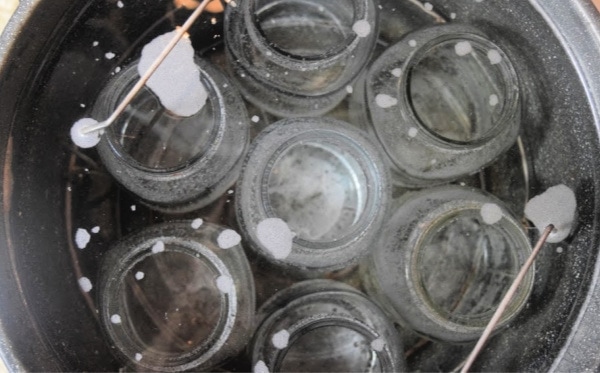Hidden Springs Homestead may earn a commission for purchases made after clicking links on this page. Learn More.
When doing food preservation in a water bath canning method, it’s crucial to you sterilize canning jars before using them in any recipe that calls for processing less than 10 minutes.
If your recipe calls for processing longer, then sterilizing canning jars is not necessary.
Also, know that when pressure canning any food, it’s also not necessary. The jars, as well as the food inside them, will be sterilized with the temperature.
Jars that are used for jams & jellies, tomatoes, juices, fruits, or even fermented or pickling recipes that will process longer than 10 minutes need not be pre-sterilized either.
Learning how to sterilize canning jars is an important part of home canning and preserving.
You should also know that you can add additional processing time to your recipe to exceed the 10 minutes and pre-sterilizing will not be necessary. This will not affect the food flavor either.
How to Clean Jars for Home Canning
Before every use, wash empty jars in hot water with detergent and rinse well by hand, or wash in a dishwasher. Detergents left on jars may cause unnatural flavors and colors. These washing methods do not sterilize jars. Scale or hard-water films on jars are easily removed by soaking jars several hours in a solution containing 1 cup vinegar (5 percent acidity) per gallon of water. Source: The National Center for Food Preservation.
So in essence, this has already eliminated one popular question people often ask “Can canning jars be sterilized in the dishwasher?” So no, the dishwasher is only for cleaning jars.
I don’t have a dishwasher so I always wash by hand. This makes it much easier to inspect each jar for cracks, nicks, and chips.

If a jar has any of these, don’t use it! It can be repurposed for a craft or storing dried herbs and such.
TIP: Its also important to mention that putting jars in the oven, or in a microwave or even an instant pot does not sterilize them either. Boiling water is the only approved safe way.
Sometimes, used jars have a film or hard water spots that look cloudy on them. You can easily remove it by soaking the jars in a homemade cleaning solution made of 1-cup of 5% vinegar to one gallon of water. And then just soak for several hours.
If I need to soak any jars, I do it the night before in my kitchen sink. Then when I wash them the next day, they come out nice, shiny and clean.
Why Do You Sterilize Canning Jars
No matter how clean your work space or home is, there are still bacteria, fungi and yeasts on surfaces. And this is normal, it doesn’t mean your home is not clean.
The bacteria’s and fungis can grow on the glass jars and are too small to be seen by the naked eye. Sterilizing is the only way to kill these. A sterile canning jar is essential in the long shelf life of a home canned food.
Equipment Needed To Sterilize Canning Jars
Sterilizing jars is not hard, it just requires some preparation but is well worth it to make sure your home-canned food is safe for long-term shelf storage.
- Canning Jars, often called Mason Jars
- Water Bath Canner with Rack
- Canning Jar Lifter or Tongs
Adjusting Altitude for Canning
Altitude affects the temperature at which water boils so the higher your altitude, the longer it takes for water to boil.
To properly sterilize jars they should boil for a full 10 minutes plus the amount of time added for your level above sea level. See the chart below:
| Feet Above Sea Level | Time for Rolling Boil |
|---|---|
| 0 – 1,000 | 10 minutes |
| 1,000 – 2,000 | 11 minutes |
| 2,000 – 3,000 | 12 minutes |
| 3,000 – 4,000 | 13 minutes |
| 4,000 – 5,000 | 14 minutes |
| 5,000 – 6,000 | 15 minutes |
| 6,000 – 7,000 | 16 minutes |
| 7,000 – 8,000 | 17 minutes |
To find out what your sea level is, CLICK HERE, enter your city, and state. Your elevation will appear in the large box.
Mine in Tennessee is 860ft so I don’t add any additional time to my recipes.
RELATED: Use “The Complete Beginners Guide To Home Canning” and get comfortable with home canning.
How to Sterilize Jars for Canning – Step by Step
To sterilize canning jars from beginning to end should take about 25 minutes give or take. This is to give the water time to heat to a boiling temperature of 212 degrees F. Once the rolling boil begins, start your timer.

Check your recipe, if it calls for processing less than 10 minutes + your altitude adjustment, then do the following…
- 1) After washing canning jars in hot soapy water, place jars, right side up inside a water bath canner or deep stockpot on a canning rack.
- 2) Completely fill all jars and water bath canner with hot water, not boiling, to one inch above the tops of jar rims.
- 3) Using high heat, bring water to a boil.
- 4) Once the water reaches a full rolling boil, begin timing and boil jars according to the required time based on your sea-level altitude.
- 5) When timer ends, turn off the heat and with a jar lifter, remove jars, one at a time, and place on a freshly cleaned towel or clean cutting board to drain – THEY WILL BE HOT!
- 6) Leave hot water in water bath canner
- 7) Fill with hot food for processing, add clean lids, tighten screw bands, and place back into the hot water.
TIP: If it will be longer than 1 hour before you are ready to fill sterilized jars, it’s advised to re-sterilize them. So planning and timing are important to think about when doing home canning.
A great source for valuable and accurate canning information is the National Center for Home Food Preparation. Check it out.
Even though it isn’t recommended to sterilize jars if the recipe calls for processing over 10 minutes, I still do it. It doesn’t hurt a thing to do it.
And not only are my mason jars sterilized and safe, but the water in my water bath canner is already “hot” so it returns to a boil much quicker for processing my recipe. This saves a few minutes waiting on the rolling boil to begin otherwise.
Use Approved Jars For Canning
If you are making refrigerator jams, you can use pretty much any type of container you prefer. Plastic jars, recycled jam jars, glass jars, and even old jars and craft jars if you want.
But if you plan on water bath canning for long shelf life to enjoy months down the road, you will need to use only approved glass jars that have been fabricated for home canning.
These jars have gone through a heat process, are tempered to not shatter, and are designed to seal and be stored at room temperature for long shelf life. These jars are often called mason jars, but there are other brands on the market.
Ball canning jars are a great jar to use and they can be found not only online but they are also readily available in grocery stores and hardware stores.
How To Clean Lids and Rings For Canning
Canning lids must also be clean and free of contaminants before they are placed on your filled jars. But they should not be boiled.
- 1) In a small saucepan, bring water to a simmer temperature of 180°F (82°C)
- 2) Place clean lids in water and simmer for 10 minutes or until you are ready to use them
- 3) Use a magnetic lifter to lift them out and place them on a hot, filled jar
And then continue to follow your recipe.
So you can see, sterilizing canning jars is not difficult, it just takes a few extra steps. But of course, canning safety should be first and foremost on our minds when we are doing it.
Do you feel more comfortable sterilizing your canning jars now? Did you learn something that you didn’t already know? I’d love to hear from you.
FAQ’s and Answers
Q: Is a dishwasher hot enough to sterilize canning jars?
A: The NCHFP states that the only approved way to sterilize canning jars by boiling water. So again, this also eliminates microwaves, ovens and instant pots.
Q: How long do I boil lids for canning?
A: The simple answer is “Don’t boil lids.” They need on be simmered in hot water (180°F) for about 10 minutes or until you are ready to put them on your hot filled jars.
Q: Can you reuse lids after boiling them?
A: Unfortunately, the answer is no. Lids are designed for one-time-use-only. Using them over is taking a huge chance your jar will not seal properly, causing the contents to spoil.
More Canning Helpers:
- How To Prepare For Canning Season
- Water Bath Canning Problems and Solutions
- How to Build Your Own Canning Shelves
How To Sterilize Jars for Canning

Sterilizing canning jars is not always necessary, but, when it is - here's how to do it properly and safe.
Materials
- mason jars for canning
- Boiling Water Canner
- water
Tools
- Canning Rack
- Jar Lifter
- Clean Towel
Instructions
Wash jars with hot soapy water and rinse well
Place jars in water bath canner with rack, and fill both jars and canner with water (not boiling) until jars a completely covered by 1 inch.
Place on stove with HIGH heat.
Once water comes to a “rapid boil” start timer and boil for 10 minutes (+ altitude adjustments when necessary). Turn off heat.
Keep jars in hot water until ready to fill with jam and jellies. Carefully remove jars, one at a time, using a jar lifter empty the water into the water-bath canner. Warning – JARS WILL BE HOT!
No need to dry them off. Just place hot jar on clean towel, and fill delicious hot food you've prepared for canning.
Continue to follow your recipe.



Connect with Hidden Springs Homestead!
Be sure to follow me on social media so you never miss a post!

Dianne Hadorn is the owner of Hidden Springs Homestead nestled in the hills of East Tennessee. She is a Master Gardener and enjoys helping others learn how to grow and preserve their own food and sharing tips for living a more self-sufficient lifestyle.

Diane… How would you sterilize your jars, lids and caps if you wanted to use them for storing dry products such as potato flakes, flour, etc. I will also be using oxygen absorbers.
Hi Jim,
To be honest, I not sure there is a reason for sterilizing for this use. Sterilization is only needed when you are canning a recipe that takes less than 10 minutes to process. I use Mason jars as canisters on my counter with oxygen absorbers for these pantry items and don’t sterilize them. But, if you want to sterilize them, you would follow the same steps and then make sure they are well dried before you put anything into them. To get them dry, you might, after they come out of the water, put them on the dry cycle in your dishwasher if you have one. But again, for storing these items, sterilizing is not required.
Does this help?
Dianne
I sterilized my jars and when I took them out of the water they had a film on and in them. I am using them for homemade vanilla extract. Any suggestion on what to do?
Hi C –
Yes, it sounds like you may have well water or hard water? To keep this from happening, pour 1/4 of 5% white distilled vinegar in the pot of water and boil your jars. The vinegar prevents the white film.
Let me know how the vanilla extract turns out. I’ve not tried it yet.